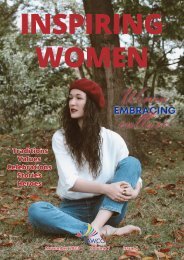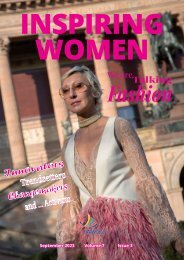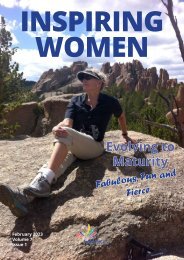Inspiring Women Magazine May 2021
You also want an ePaper? Increase the reach of your titles
YUMPU automatically turns print PDFs into web optimized ePapers that Google loves.
FEATURE<br />
What is Tai Chi?<br />
Roxey Lau, member of Munich<br />
IWC, tells us about the practice<br />
of tai chi and its role in her life.<br />
Tai chi, besides being a Chinese martial art, is a<br />
holistic healing art that embraces body, mind and<br />
spirit. It involves a system of exercises or<br />
movements that promote health, prevent<br />
degenerative illnesses and promote longevity.<br />
Often described as “meditation in motion,” it can<br />
just as well be called “medication in motion,” due<br />
to its wide array of health benefits. Tai chi<br />
movements exercise the entire body, not just<br />
individual muscles or muscle groups. It stimulates<br />
circulation and vital organs, aligns bones,<br />
mobilizes joints, enhances breathing, and<br />
improves balance, posture and coordination.<br />
The importance of good posture<br />
Most children enjoy natural and unrestricted<br />
movements. But as they grow up, many start to<br />
lose this quality of movement. Incorrect alignment<br />
of the frame – the bones, joints and muscles – can<br />
lead to structural problems, such as slipped discs,<br />
back pain and joint malfunction. Tai chi teaches<br />
body awareness, so that good posture, when<br />
lying, sitting, standing and moving, becomes<br />
natural. One of the main aims of tai chi is to<br />
restore to the adult body the flexibility it enjoyed<br />
in early childhood.<br />
Tai chi origins<br />
According to Chinese legends, about a thousand<br />
years ago, during the Song Dynasty, a man named<br />
Zhang San Feng one day came upon a fight<br />
between a magpie and a snake. Zhang was awestruck<br />
at the constant repositioning of the two<br />
creatives who shifted effortlessly from attack to<br />
defense and back again, finally breaking off, as if<br />
by mutual agreement, and going their separate<br />
ways. Zhang marveled at the fluidity of those<br />
movements and the wonderful appropriateness<br />
of their ever-changing stances. Suddenly<br />
enlightened, he saw a previously unidentified<br />
source of strength within the human body.<br />
Zhang recognized that the quality present in the<br />
martial dance of the snake and the magpie was<br />
nothing more than softness, a mysterious and<br />
powerful element that could be developed in<br />
human beings. He decided to find out how. To<br />
prove that softness overcomes hardness in the<br />
fighting arts, Zhang withdrew from the world for<br />
several years to test his hypothesis.<br />
Eventually, he succeeded in creating a wondrous<br />
style that differed from all the other systems of<br />
martial arts in his time. Today Zhang’s principles<br />
and method of training have come to be known as<br />
tai chi.<br />
The philosophy of Taoism<br />
Roxey with some of the children she has taught<br />
Tai chi stems from the philosophy of Taoism, an<br />
ancient Chinese system of thought that attempts<br />
15

















